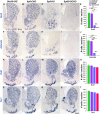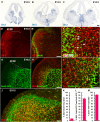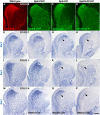SP8 and SP9 coordinately promote D2-type medium spiny neuron production by activating Six3 expression
- PMID: 29967281
- PMCID: PMC6078334
- DOI: 10.1242/dev.165456
SP8 and SP9 coordinately promote D2-type medium spiny neuron production by activating Six3 expression
Abstract
Dopamine receptor DRD1-expressing medium spiny neurons (D1 MSNs) and dopamine receptor DRD2-expressing medium spiny neurons (D2 MSNs) are the principal projection neurons in the striatum, which is divided into dorsal striatum (caudate nucleus and putamen) and ventral striatum (nucleus accumbens and olfactory tubercle). Progenitors of these neurons arise in the lateral ganglionic eminence (LGE). Using conditional deletion, we show that mice lacking the transcription factor genes Sp8 and Sp9 lose virtually all D2 MSNs as a result of reduced neurogenesis in the LGE, whereas D1 MSNs are largely unaffected. SP8 and SP9 together drive expression of the transcription factor Six3 in a spatially restricted domain of the LGE subventricular zone. Conditional deletion of Six3 also prevents the formation of most D2 MSNs, phenocopying the Sp8/9 mutants. Finally, ChIP-Seq reveals that SP9 directly binds to the promoter and a putative enhancer of Six3 Thus, this study defines components of a transcription pathway in a regionally restricted LGE progenitor domain that selectively drives the generation of D2 MSNs.
Keywords: DRD2; LGE; Medium spiny neuron; Mouse; Six3; Sp8; Sp9; Striatum.
© 2018. Published by The Company of Biologists Ltd.
Conflict of interest statement
Competing interestsJ.L.R. is a co-founder and stockholder, and is currently on the scientific board, of Neurona, a company studying the potential therapeutic use of interneuron transplantation.
Figures









Similar articles
-
Homeobox Gene Six3 is Required for the Differentiation of D2-Type Medium Spiny Neurons.Neurosci Bull. 2021 Jul;37(7):985-998. doi: 10.1007/s12264-021-00698-5. Epub 2021 May 20. Neurosci Bull. 2021. PMID: 34014554 Free PMC article.
-
Dlx1/2-dependent expression of Meis2 promotes neuronal fate determination in the mammalian striatum.Development. 2022 Feb 15;149(4):dev200035. doi: 10.1242/dev.200035. Epub 2022 Feb 23. Development. 2022. PMID: 35156680 Free PMC article.
-
Zfhx3 is required for the differentiation of late born D1-type medium spiny neurons.Exp Neurol. 2019 Dec;322:113055. doi: 10.1016/j.expneurol.2019.113055. Epub 2019 Sep 3. Exp Neurol. 2019. PMID: 31491374
-
D1 and D2 dopamine-receptor modulation of striatal glutamatergic signaling in striatal medium spiny neurons.Trends Neurosci. 2007 May;30(5):228-35. doi: 10.1016/j.tins.2007.03.008. Epub 2007 Apr 3. Trends Neurosci. 2007. PMID: 17408758 Review.
-
Reappraising striatal D1- and D2-neurons in reward and aversion.Neurosci Biobehav Rev. 2016 Sep;68:370-386. doi: 10.1016/j.neubiorev.2016.05.021. Epub 2016 May 24. Neurosci Biobehav Rev. 2016. PMID: 27235078 Review.
Cited by
-
DNA methylation and hydroxymethylation characterize the identity of D1 and D2 striatal projection neurons.Commun Biol. 2022 Dec 1;5(1):1321. doi: 10.1038/s42003-022-04269-w. Commun Biol. 2022. PMID: 36456703 Free PMC article.
-
Chd5 Regulates the Transcription Factor Six3 to Promote Neuronal Differentiation.Stem Cells. 2023 Mar 17;41(3):242-251. doi: 10.1093/stmcls/sxad002. Stem Cells. 2023. PMID: 36636025 Free PMC article.
-
Humanized substitutions of Vmat1 in mice alter amygdala-dependent behaviors associated with the evolution of anxiety.iScience. 2022 Jul 20;25(8):104800. doi: 10.1016/j.isci.2022.104800. eCollection 2022 Aug 19. iScience. 2022. PMID: 35992083 Free PMC article.
-
Diversity in striatal synaptic circuits arises from distinct embryonic progenitor pools in the ventral telencephalon.Cell Rep. 2021 Apr 27;35(4):109041. doi: 10.1016/j.celrep.2021.109041. Cell Rep. 2021. PMID: 33910016 Free PMC article.
-
Diet-Induced Obesity Induces Transcriptomic Changes in Neuroimmunometabolic-Related Genes in the Striatum and Olfactory Bulb.Int J Mol Sci. 2024 Aug 28;25(17):9330. doi: 10.3390/ijms25179330. Int J Mol Sci. 2024. PMID: 39273278 Free PMC article.
References
-
- Castro D. S., Martynoga B., Parras C., Ramesh V., Pacary E., Johnston C., Drechsel D., Lebel-Potter M., Garcia L. G., Hunt C. et al. (2011). A novel function of the proneural factor Ascl1 in progenitor proliferation identified by genome-wide characterization of its targets. Genes Dev. 25, 930-945. 10.1101/gad.627811 - DOI - PMC - PubMed
Publication types
MeSH terms
Substances
Grants and funding
LinkOut - more resources
Full Text Sources
Other Literature Sources
Molecular Biology Databases

